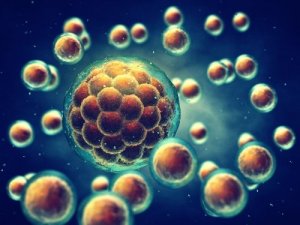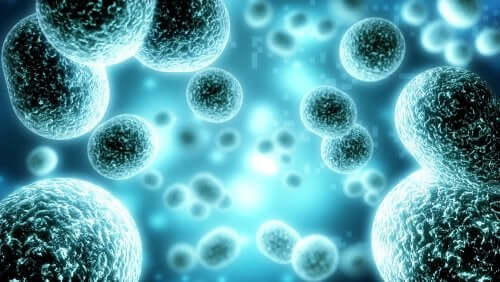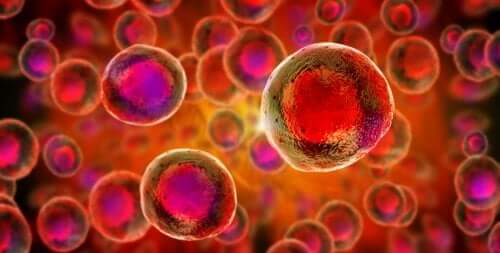Stem Cells and Umbilical Cord Conservation


Written and verified by the biologist Olga Carbajo
The purpose of this article is not to convince you of the need for umbilical cord conservation. Nor is it aimed at selling you on the need to carry out genetic testing during your pregnancy. Lastly, we don’t intend to make anyone feel bad about not doing it.
If you continue reading, it’s because you agree with us that it’s important to be informed in order to make a good decision. Today’s informative article will help answer your questions about stem cells and umbilical cord conservation.
What are stem cells and umbilical cord conservation?
Stem cells are the first cells to form in an organism. They’re said to be totipotential, as they’re able to produce the rest of the cell lines with specialized functions. What’s more, they can also give way to more stem cells. But, what makes them so special?
Characteristics of stem cells
The characteristics of stem cells make them the most important focus of current studies. This is especially true in studies regarding gene therapies and the knowledge of human development. At the same time, we can summarize these defining characteristics in three key points:
- They have the ability to divide and renew themselves, forming daughter cells.
- They can differentiate and mature, creating specialized cells like neurons, erythrocytes…
- Stem cells can be cultivated in a laboratory in order to obtain stem cell lines.

Truth be told, stem cell lines are used as a source of progenitor cells. They come from one original stem cell and cannot differentiate. Normally, they’re free of congenital defects and, in general, are used both in gene therapies as well as investigation and research.
What types of progenitor cells are there?
The miracle of life has its origins in one sole cell. In the moments following fertilization, this embryo holds in its interior all the information necessary for the development of an entire organism. After 24 hours, the cells of the zygote remain pure, are capable of producing a complete embryo. This is what qualifies them as being totipotential.
However, after the 7th day after fertilization, according to the advancement of embryonic development, stem cells differentiate, mature, and lose this capacity. Now they can still produce any type of cell line, but not a complete embryo.
The genes in charge of that capacity have now been suppressed. As a result, these differentiated stem cells are known as “pluripotencial” or embryonic.
Where do stem cells come from?
Currently, research has revealed two sources of progenitor cells. The first are embryos in their early state, which is where we obtain embryonic stem cells. The second source of stem cells is the adult organism. So, what’s the difference?
Embryonic stem cells
Embryonic stem cells can be obtained between the 4th and 7th day. In general, they come from an excess generated in in vitro fertilization treatments. This practice is a source of great controversy, as it involves the destruction of a healthy and viable embryo. In rare cases, they can be obtained from aborted embryos or from carconomas, a type of fetal tumor.
These stem cells are of great therapeutic use. As we stated above, they’re pluripotential cells, capable of producing any type of cell. They’re useful in therapies involving the regeneration of tissues or organs.
However, to date, orienting the process of cellular differentiation towards the desired cell type is still complicated. Therefore, these treatments are still under investigation.
Adult stem cells
Although in very small quantities, we can find adult stem cells in almost all of the body’s tissues. Most studies and treatments concentrate on obtaining progenitor cells from bone marrow, given its accessibility.
The problem with these cell types is their level of maturity. They’ve lost their ability to generate any type of cell, and are now “multipotential.”
However, recent studies conducted by doctor Catherine Verfaillie, professor and director of the Stem Cell Institute at the University of Minnesota, reveal new information. The studies indicate that these multipotential cells aren’t only able to produce blood cells, but brain and heart cells as well.
Her team has managed to produce brain cells from mesenchymal stem cells cultivated in a laboratory. This evidence suggests that adult stem cells may be more plastic than they seem.
But what is conserving stem cells from the umbilical cord all about?
Thanks to studies like that of Dr. Verfaille, researchers have been able to find special progenitor cells in umbilical cord blood. Mesenchymal stem cells, even as adult cells, conserve their ability to produce distinct cell types.
The use of our own cells opens the doors to regenerative medicine. In other words, the possibility of replacing sick cells with healthy ones, while avoiding the risk of rejection.
This application is of vital importance for patience with leukemia. However, a great deal of continued investigation must take place in order to maximize the benefits in future medical treatments.

What options are there for umbilical cord conservation?
Currently, there are several options available for umbilical cord conservation. For example, parents can donate the blood from their baby’s umbilical cord and placenta to a public cord blood bank. The medical community encourages donating stem cells in this way, allowing for their use in research and gene therapy.
Private cord blood banks also exist, which offer their users the cryopreservation of the umbilical cord. The stems cells contained within serve as a potential safeguard for the family in the future.
However, this procedure may involve high costs for families, without a clear indication of their true utility.
In fact, experts warn that preservation for autologous use should be limited. When patients with leukemia want to save their own stem cells, there is a high risk that these cells contain the same cancer-causing genetic defect. Of course, the possibility of looking for compatibility between siblings always exists.
“We used to think that our fate was in our stars. Now we know, in large part, that our fate is in our genes.”
–J.Watson–
The purpose of this article is not to convince you of the need for umbilical cord conservation. Nor is it aimed at selling you on the need to carry out genetic testing during your pregnancy. Lastly, we don’t intend to make anyone feel bad about not doing it.
If you continue reading, it’s because you agree with us that it’s important to be informed in order to make a good decision. Today’s informative article will help answer your questions about stem cells and umbilical cord conservation.
What are stem cells and umbilical cord conservation?
Stem cells are the first cells to form in an organism. They’re said to be totipotential, as they’re able to produce the rest of the cell lines with specialized functions. What’s more, they can also give way to more stem cells. But, what makes them so special?
Characteristics of stem cells
The characteristics of stem cells make them the most important focus of current studies. This is especially true in studies regarding gene therapies and the knowledge of human development. At the same time, we can summarize these defining characteristics in three key points:
- They have the ability to divide and renew themselves, forming daughter cells.
- They can differentiate and mature, creating specialized cells like neurons, erythrocytes…
- Stem cells can be cultivated in a laboratory in order to obtain stem cell lines.

Truth be told, stem cell lines are used as a source of progenitor cells. They come from one original stem cell and cannot differentiate. Normally, they’re free of congenital defects and, in general, are used both in gene therapies as well as investigation and research.
What types of progenitor cells are there?
The miracle of life has its origins in one sole cell. In the moments following fertilization, this embryo holds in its interior all the information necessary for the development of an entire organism. After 24 hours, the cells of the zygote remain pure, are capable of producing a complete embryo. This is what qualifies them as being totipotential.
However, after the 7th day after fertilization, according to the advancement of embryonic development, stem cells differentiate, mature, and lose this capacity. Now they can still produce any type of cell line, but not a complete embryo.
The genes in charge of that capacity have now been suppressed. As a result, these differentiated stem cells are known as “pluripotencial” or embryonic.
Where do stem cells come from?
Currently, research has revealed two sources of progenitor cells. The first are embryos in their early state, which is where we obtain embryonic stem cells. The second source of stem cells is the adult organism. So, what’s the difference?
Embryonic stem cells
Embryonic stem cells can be obtained between the 4th and 7th day. In general, they come from an excess generated in in vitro fertilization treatments. This practice is a source of great controversy, as it involves the destruction of a healthy and viable embryo. In rare cases, they can be obtained from aborted embryos or from carconomas, a type of fetal tumor.
These stem cells are of great therapeutic use. As we stated above, they’re pluripotential cells, capable of producing any type of cell. They’re useful in therapies involving the regeneration of tissues or organs.
However, to date, orienting the process of cellular differentiation towards the desired cell type is still complicated. Therefore, these treatments are still under investigation.
Adult stem cells
Although in very small quantities, we can find adult stem cells in almost all of the body’s tissues. Most studies and treatments concentrate on obtaining progenitor cells from bone marrow, given its accessibility.
The problem with these cell types is their level of maturity. They’ve lost their ability to generate any type of cell, and are now “multipotential.”
However, recent studies conducted by doctor Catherine Verfaillie, professor and director of the Stem Cell Institute at the University of Minnesota, reveal new information. The studies indicate that these multipotential cells aren’t only able to produce blood cells, but brain and heart cells as well.
Her team has managed to produce brain cells from mesenchymal stem cells cultivated in a laboratory. This evidence suggests that adult stem cells may be more plastic than they seem.
But what is conserving stem cells from the umbilical cord all about?
Thanks to studies like that of Dr. Verfaille, researchers have been able to find special progenitor cells in umbilical cord blood. Mesenchymal stem cells, even as adult cells, conserve their ability to produce distinct cell types.
The use of our own cells opens the doors to regenerative medicine. In other words, the possibility of replacing sick cells with healthy ones, while avoiding the risk of rejection.
This application is of vital importance for patience with leukemia. However, a great deal of continued investigation must take place in order to maximize the benefits in future medical treatments.

What options are there for umbilical cord conservation?
Currently, there are several options available for umbilical cord conservation. For example, parents can donate the blood from their baby’s umbilical cord and placenta to a public cord blood bank. The medical community encourages donating stem cells in this way, allowing for their use in research and gene therapy.
Private cord blood banks also exist, which offer their users the cryopreservation of the umbilical cord. The stems cells contained within serve as a potential safeguard for the family in the future.
However, this procedure may involve high costs for families, without a clear indication of their true utility.
In fact, experts warn that preservation for autologous use should be limited. When patients with leukemia want to save their own stem cells, there is a high risk that these cells contain the same cancer-causing genetic defect. Of course, the possibility of looking for compatibility between siblings always exists.
“We used to think that our fate was in our stars. Now we know, in large part, that our fate is in our genes.”
–J.Watson–
All cited sources were thoroughly reviewed by our team to ensure their quality, reliability, currency, and validity. The bibliography of this article was considered reliable and of academic or scientific accuracy.
- Mayo Clinic (24 enero 2019). Células madre: qué son y qué hacen[artículo en web]. Recuperado de: www.mayoclinic.org
- Pérez de la Prada, M.T. (última consulta mayo 2019). Las células madre o progenitoras [artículo del libro La salud cardiovascular]. Recuperado de: www.fbbva.es
- Universidad de Minnesota (última consulta mayo 2019). Acerca de C.M. Verfaillie [artículo en web científica]. Recuperado de: www.michaeljfox.org
- Sutil, M (29 mayo 2017). En España no hay banco privado para guardar el cordón umbilical [artículo en revista digital]. Recuperado de: www.diariomedico.com
This text is provided for informational purposes only and does not replace consultation with a professional. If in doubt, consult your specialist.








